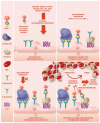Inflammatory Biomarkers in the Short-Term Prognosis of Venous Thromboembolism: A Narrative Review
- PMID: 33807848
- PMCID: PMC7961591
- DOI: 10.3390/ijms22052627
Inflammatory Biomarkers in the Short-Term Prognosis of Venous Thromboembolism: A Narrative Review
Abstract
The relationship between inflammation and venous thrombosis is not well understood. An inflammatory response may be both the cause and consequence of venous thromboembolism (VTE). In fact, several risk factors of VTE modulate thrombosis through inflammatory markers. Acute pulmonary embolism (PE) is burdened by a remarkable mortality rate, up to 34% in severely ill patients presenting with hemodynamic instability. Initial mortality risk stratification is based on hemodynamic instability. Patients with a situation of hemodynamic stability require immediate further risk assessment based on clinical, imaging, and circulating biomarkers, as well as the presence of comorbidities. Some inflammatory biomarkers have shown potential usefulness in the risk stratification of patients with VTE, especially acute PE. C-reactive protein on admission is associated with 30-day mortality and bleeding in VTE patients. P-selectin is associated with right ventricle dysfunction in PE patients and might be associated with VTE recurrences and the extension of thrombosis. Tissue factor microparticles are associated with VTE recurrence in cancer-associated thrombosis. Other inflammatory biomarkers present scarce evidence (inflammatory cytokines, erythrocyte sedimentation rate, fibrinogen, leukocyte count). In this manuscript, we will review the prognostic role of different inflammatory biomarkers available both for clinical practice and research in VTE patients.
Keywords: P-selectin; biomarkers; deep vein thrombosis; inflammation; prognostic; pulmonary embolism; reactive C protein; venous thromboembolism.
Conflict of interest statement
F.G.-V.: Speakers’ Bureau: Techdow, Rovi; L.O.-O. declares that there are no conflicts of interest; C.M.O. declares that there are no conflicts of interest; J.D.-T.-C.: Consulting or Advisory Role: Boehringer, Ingelheim, Techdow; Speakers’ Bureau: Rovi, Sanofi and Aspen; L.A.-S.-W. declares that there are no conflicts of interest; P.D.-R.: Consulting or Advisory Role: Boehringer, LEO Pharma, Ingelheim, Techdow; Speakers’ Bureau: Rovi, Sanofi and Aspen. The sponsors had no role in the design, execution, interpretation, or writing of the study.
Figures

References
Publication types
MeSH terms
Substances
LinkOut - more resources
Full Text Sources
Other Literature Sources
Medical
Research Materials

